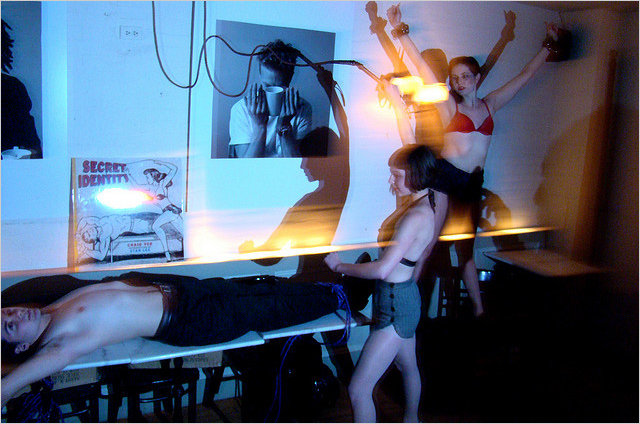Talking about BDSM safety can be a turn-off, but you owe it to both you and your partner or fuck buddy to have the chat. Especially kink play can be harder and rougher, adding potentially more risk for infection. Here are five ways to enjoy safer kinky sex.
When it comes to sex, nothing is completely safe. Everything has a risk factor, and that’s also true of BDSM. In order to reduce these risks, the fetish community has formulated many subtle methods of enjoying kinky sex and always being ready for more.
1. We need to talk about BDSM safety
Communication lies at the heart of most satisfying sexual experiences, whether it’s love, lust, or both, BDSM safety is about knowing the territory you and your partner feel confident in exploring. Pushing at the boundaries can be massively arousing for you both, but when one person is more eager to go further in an encounter, the atmosphere can get tense both in and out of bed. How far to go is a question that can only be answered by you and your partner.
There are endless kinky possibilities, but most within the community agree that certain things need to be left in the realms of fantasy. Without a line that you don’t cross, there’s a real chance someone could end up in the hospital at the end of the night, and no responsible partner wants that. Safe, Sane and Consensual or SSC is a phrase often applied to the kind of kinky sex that doesn’t exploit or freak out any participant. It’s a way of differentiating between relationships that include genuinely abusive mistreatment, and those which play with these ideas in a mutually pleasurable way.
2. Keep watching the lights
During vanilla sex, the rules are pretty straight forward: you can ask a partner if they like what you’re doing or if it feels good, and expect to get both verbal and physical responses to your moves. However, in the throes of a bondage session, it can be impossible to distinguish screams of ecstatic fulfilment or teasing rebellion from those of real fear. In the S&M community, we love a bit of drama and theatre with our sex, so we make it easier to detect how things are going from your partner’s perspective with a few important code words.
Most of us know about safe words, and the most commonly used in public events are ‘safeword’ and ‘red’. It makes sense to use these general usage terms at play parties or during any group sex situation because you’ll immediately be understood. In the intimate surroundings of your boudoir, though, you could try the traffic light system. This allows participants to check-in with each other during a sadomasochistic happening, without ruining the flow. The dominant growls ‘red, yellow, green’ in their submissive’s ear and hopes for a ‘green!’, they’ll rein it in for a ‘yellow’ and stop dead if the response is ‘red’. It’s simple and effective without either kinkster having to break character.

Image: Istolethetv via Flickr.com CC BY 2.0 license
3. Party with the BDSM safety professionals
People in the BDSM community often suggest that newcomers to the lifestyle first try out some bondage action at a party. You might not have a partner yet, or maybe the two of you could do with some inspiration from more depraved bondage friends. Either way, these hedonistic gatherings are ideal for consolidating your relationship and learning new kinky tricks to try at home. Indeed, you’ll meet people who are involved in the lifestyle and begin to make contacts that could become friends.
4. Carry on loving
S&M sex can be rough and emotionally draining, so when a scene has ended, aftercare is an important part of the comedown, especially for anyone who has bottomed. Regular blows to the body and forceful treatment lead to a release of endorphins and create a buzzing, addictive high. That’s why being involved in a BDSM moment can feel painless, like being ragingly drunk, it only bites back later.
In fact, the discomfort can be both psychological and physical; people feel drained, exhausted and sore... that’s why this state is often referred to as the ‘drop’. Usually, everyone recovers from safer kinky sex within a few hours, as long as they have the right care. Helping others involves basic kindness, like putting them in a comfortable spot to rest. Also, keep them warm, provide an indulgent snack like chocolate and offer a drink. A lot of subs say that after a heavy S&M session, another person ‘just being around’ to chat or sit quietly, helps put them back together.
5. Commit to BDSM safety
It goes without saying that you should always use protection like barriers or condoms when appropriate. If you like to cuff during sex, only ever use toys with a common key and never bind using a material you can’t easily cut off. Some of us are happy to be marked, others will go even further during heavy play, but what makes this different from abuse is mutual consent: we wouldn’t be doing it if we didn’t crave it.
Do you always talk about BDSM safety with partners, or does it kill the moment for you? Share your thoughts in the Fetish.com forum. 
.gif.81d0c0442ce9717e871ade8e7d5b0dd8.gif)






Join the conversation
You can post now and register later. If you have an account, sign in now to post with your account.